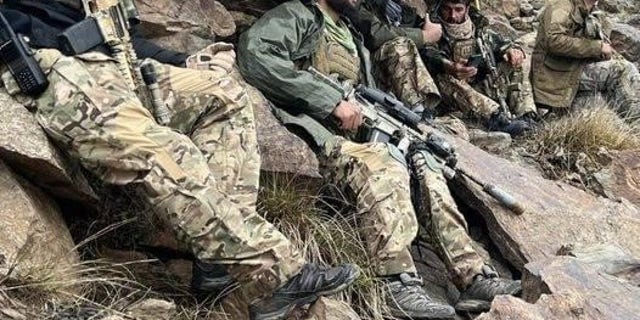
NEWYou can now listen to Fox News articles!
Afghanistan’s lead resistance group, the National Resistance Front (NRF), has one message for the Biden administration: don’t ignore terror threats coming from Afghanistan. The group noted that mistake was made by the Clinton administration in the lead up to the 9/11 terror attacks.
In a statement to Fox News Digital, the NFR’s head of foreign relations, Ali Maisam Nazary, said the time for action is now.
“Our message to the Biden administration is to not make the same mistake the Clinton administration (made) when they ignored the threat of terrorism in the mid and late 1990s and led to 9/11. The White House has to act fast and adopt a proactive approach to counterterrorism by allowing democratic and anti-terrorist forces like the NRF to liberate Afghanistan,” he said.
TALIBAN’S POWER CHALLENGED BY AFGHAN RESISTANCE FRONT, ISIS-K
The warning comes as the Taliban is facing a new low-intensity campaign in the north from rebels, who in recent weeks have launched attacks against its fighters.
Afghanistan’s fighting season is known to start in the spring and generally run through October. In previous years this was when the Taliban and its allies would wage attacks against U.S. forces and the Afghan National Security Forces (ANSF).
The current fighting is largely happening in the north of the country and is being led by the NRF in the country’s Panjshir Valley, a rugged and mountainous bastion of anti-Taliban resistance north of Kabul where the Taliban consolidated its control last September.

National Resistance Front rebels have been launching attacks against the Taliban in the Panjshir valley (National Resistance Front)
The NRF, led by Ahmad Massoud, is viewed as the most formidable Afghan resistance unit fighting the Taliban, and its leader has vowed to continue the fight even after the loss of its rear base in the Panjshir Valley. Massoud’s father, Ahmad Shah Massoud, was a prominent Mujahidin rebel who fought against the Soviets in 1980s and was assassinated by al Qaeda operatives just two days before the 9/11 attacks.
AFGHAN CITIZENS WHO HELPED US NOW WAITING IN LIMBO FOR VISA APPROVAL MONTHS AFTER EVACUATING
The NRF has extensive knowledge of the difficult terrain in Afghanistan, and like the Taliban’s insurgency against U.S. forces, will utilize asymmetric tactics against the better equipped Taliban.
Even though overthrowing the Taliban is highly unlikely, especially without an external patron, that doesn’t mean the NRF won’t cause trouble for the Taliban. Sibghattullah Ahmadi, a spokesperson for the NRF, said in a tweet earlier this month that the Taliban launched an attack at the Shaba base and lost eight fighters to NRF forces.
Ali Maisam Nazary said the NRF is taking the fight to the Taliban in the spring fighting season.
“There has been an offensive by NRF in Panjshir, Baghlan, Takhar and Badakhshan provinces and even with reinforcements the Taliban faced causalities the NRF inflicted, including prominent commanders in the past 10 days and the fighting is still going on,” Nazary told Fox News Digital.
He added, “This shows us their weaknesses, and their supposed strength from the leftover U.S. equipment was useless.”
TALIBAN DIVISIONS DEEPEN AS AFGHAN WOMEN DEFY VEIL EDICT
He also claimed the Taliban are committing war crimes and have increased attacks on civilians in a desperate attempt to regain control of restive provinces.
Taliban officials initially denied the fighting but then were forced to acknowledge it when photographs of their dead began to spread on the internet and social media. Fox News Digital has not independently confirmed the below photo supplied by the National Resistance Front. The photo is said to show Taliban casualties from recent fighting between the two sides.
WARNING:IMAGE BELOW MAY BE DISTURBING

The National Resistance Front claims several Taliban fighters were killed in recent fighting between the groups. WARNING: IMAGE MAY BE DISTURBING (The National Resistance Front )
Resistance to the Taliban has not only come from the NRF but includes other lesser-known armed groups that share the common goal of dislodging the Taliban from power. Beyond their desire for a Taliban-free Afghanistan, there is very little cooperation or coordination among the disparate groups, which hinders their ability to seriously challenge the Taliban.
Most analysts and observers do not view the National Resistance Front or other armed groups as an existential threat to the Taliban’s hold on power. External backing is a key ingredient to sustaining a successful insurgent campaign and so far, the NRF lacks any major outside support.
US ABANDONED $7B IN MILITARY EQUIPMENT IN AFGHANISTAN AHEAD OF TALIBAN TAKEOVER
“For the NRF to pose a real strategic threat to the Taliban, they will need to gain stronger external support, for supplies of weapons, shelter and training. But neighboring states are still more worried about a destabilized Afghanistan than about assisting to overthrow the Taliban, so there is only moderate support for the NRF abroad”, noted Roger Baker, director at Stratfor Center for Applied Geopolitics at RANE.
There also does not appear to be any appetite from the Biden administration or Congress to fund the anti-Taliban resistance. While the Biden administration continues to honor the withdrawal agreement struck during the Trump administration, analysts believe it has no interest in funding the nascent anti-Taliban insurgency.

National Resistance Front fighters in Afghanistan have launched attacks against the Taliban (National Resistance Front)
CLICK HERE TO DOWNLOAD FOX NEWS APP
Observers warn that a significant U.S. investment in the NRF would likely destabilize Afghanistan further and could exacerbate the already catastrophic humanitarian crisis. While the Taliban are likely to remain in power, it’s clear their new government is struggling to pacify the entire country.
Afghanistan’s Islamic State affiliate, known as the Islamic State Khorasan Province (ISIS-K), also poses a threat to Afghanistan’s stability. Unlike most of the resistance groups that desire a free and democratic Afghanistan, ISIS-K is committed to an uncompromising goal of creating a transnational Islamic caliphate and regards the Taliban as apostates for negotiating with the United States.
ISIS-K recently claimed responsibility for a string of terror attacks in Mazar-i-Sharif and Kunduz in late April, killing at least 20 people. A United Nations report in February, estimated that ISIS-K’s strength in Afghanistan has almost doubled from 2,200 members to almost 4,000.








